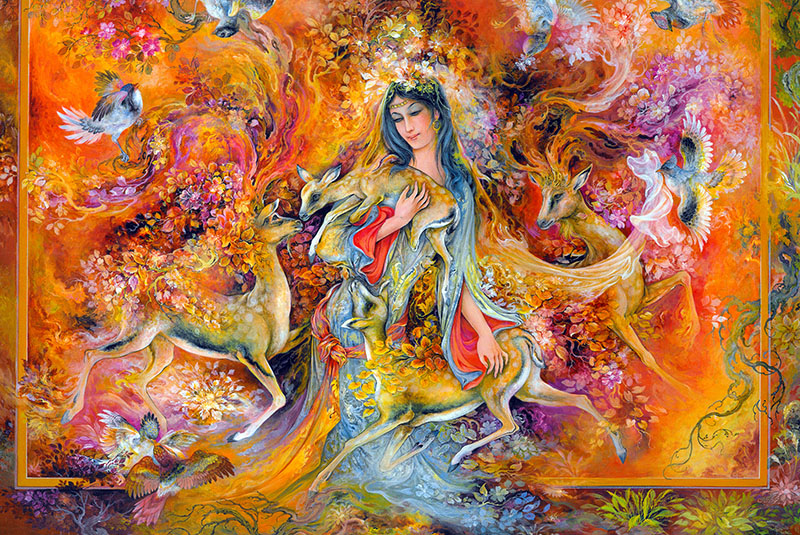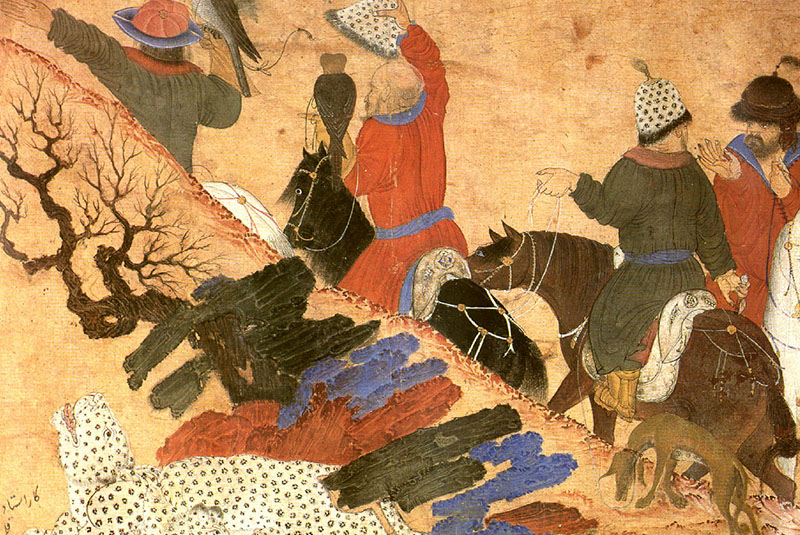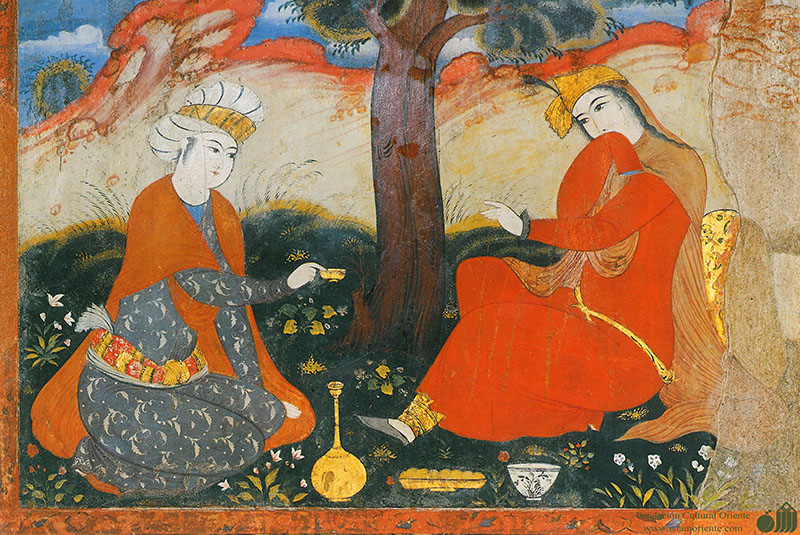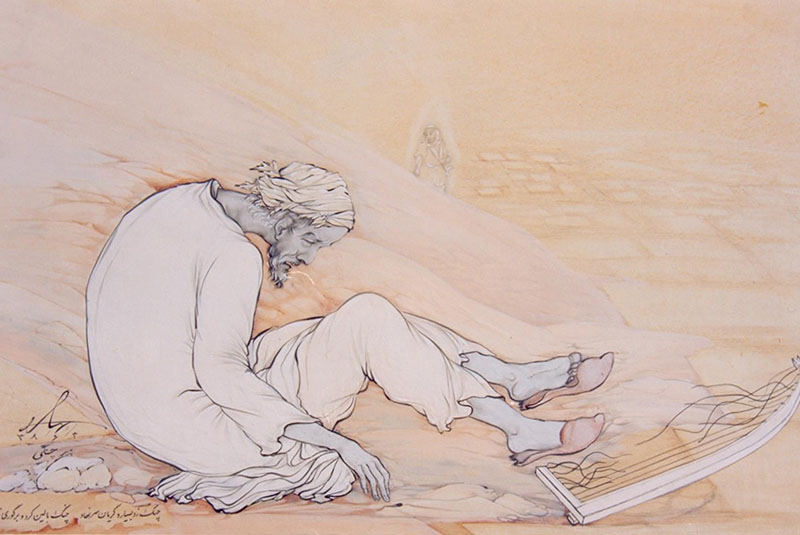Persian Miniature; The Breathtaking Flourished Persian Art
Iranians are known for being great artists. When you travel to Iran, in every corner of the country you can find a unique type of handicraft and artwork.
Among all of them, one which goes back to at least a thousand years ago is the Persian Miniature. It is actually a richly detailed miniature painting that depicts religious or mythological themes. This breathtaking art flourished from the 13th through the 16th centuries in Iran. Still, several contemporary artists use this method to create notable Persian Miniatures. These delicate, lush paintings are visually stunning, with a level of detail that can only be achieved with a very fine hand and an extremely small brush.
Important Features of the Persian Miniatures
Several features of Persian miniatures stand out. The first is the size and level of detail; many of these paintings are quite small, but they feature rich, complex scenes which can occupy a viewer for hours. Classically, a Persian miniature also features accents in gold and silver leaf, along with a very vivid array of colors. The perspective in a Persian miniature also tends to be very intriguing, with elements overlaid on each other in ways that sometimes feel awkward to people who are accustomed to the look and feel of Western art.
| Find related articles here: Persian Art
The History of Persian Miniature

The first miniature paintings in Iran date back to the beginning of the Islamic period; between the 7th and 10th century, influenced by the Sassanid, Manain, and Byzantine art that are called the Baqdad or Abbasi school. Of course, the influences of the Middle Asian themes and meanings were observable although biased Caliphs had prohibited human figures to be painted.
Persian miniature painting is a rich and enduring tradition that has its roots in ancient Persia (modern-day: Iran). Here's an overview on history of Persian miniature art:
Ancient Origins (c. 6th Century BCE - 7th Century CE)
- Persian miniature art can be traced back to ancient Persia, where it evolved from a combination of influences, including ancient Persian, Mesopotamian, and Islamic traditions.
- Early Persian miniatures were found in manuscripts, often depicting religious and historical themes. The art form began to flourish during the Sasanian Empire (c. 3rd to 7th century CE).
The Seljuk Period (1037–1194)
Seljuk paintings are indicative of some unified style and perception. The pictorial presentation was so strong then that started to extend beyond the geographical borders to the other nations under Seljuks’ domination. This style had two major characteristics round full faces and a completely contoured style in representing bodies, plants, animals and natural landscapes.
The Mongol Period and the Ilkhanids (13th Century CE - 14th Century CE)
- The Mongol invasion of Persia in the 13th century had a significant impact on Persian culture, including miniature painting.
- During the Ilkhanid period, Persian miniature art began to take on distinctive characteristics, including more detailed and vibrant compositions.
The Ilkhanid Period (1256-1353)
According to the historical evidence and paintings from that time, it is believed that Iranian start doing miniature from the Ilkhanid period and the main center of the art was the current city of Tabriz. At that time artists introduced new motifs, including Chinese-influenced features such as dragons, lotuses, and peonies. Among the most famous Ilkhanid artists was Ahmad Musa, described by the 16th-century painter Dust Muhammad as the man who ‘unveiled the face of painting’.
An example of the most ancient Iranian miniature is the drawings of a book called “Manafe-alHayvan” (1299 AD). This book describes the characteristics of animals. The natural history is mixed and narrated through the ancient fables in this book.
| Read more: Farshchian Museum - The Largest Collection of Mahmoud Farshchian
The Jalayirid Period (1340-1411)
Under the governor of the Jalayirid Kingdom, the dramatic Ilkhanid style of painting was replaced by a more tranquil vision. The paintings that have survived from this period tend to depict subjects popular in contemporary poetry, such as battle scenes and heroic accomplishments. One of the most celebrated Jalayirid artists was Junayd, a pupil of Shams al-Din (who had himself been a pupil of Ahmad Musa).
The Timurid Period (c. 1370-1507)
- The Timurid Empire (15th century) witnessed a flourishing of Iran’s miniature art. The Timurid rulers were great patrons of the arts, leading to advancements in the field.
- The Safavid Dynasty (16th to 18th centuries) continued to support the arts, particularly miniature painting. The Safavids produced some of the most famous Iranian miniatures.
Timurid rulers were great supporters of all different types of art and as a result, many artists have been attracted to their region. Due to their passion for art, the Eastern Islamic world became a significant cultural hub. One of the most famous Persian artists from this period was Kamal al-Din Bihzad. Bihzad transformed the more rigid, academic painting style common in the early years of the Timurid dynasty, injecting more life and individuality. His treatment of rocks, trees, and vegetation was more naturally rendered than those of his predecessors.
| Related: Hossein Behzad - Master of Iranian Miniature

Bihzad's most famous works include "The Seduction of Yusuf" from Sa'di's Bustan of 1488, and paintings from the British Library's Nizami manuscript of 1494-95 - particularly scenes from Layla and Majnun and the Haft Paykar. The attribution of specific paintings to Bihzad himself is often problematic, but the majority of works commonly attributed to him date from 1488 to 1495.
The Safavid Dynasty (1501-1736)
During the Safavid Dynasty, many magnificent illustrated manuscripts continued to be produced in a unique style. This style is characterized by a tendency to divide the illumination into geometrically defined sections, with complex architectural forms painted in bright colors. During this period lines become more calligraphic, human figures fill out, and artists favor a palette of browns, purples, and yellows.
| Read more: Shahnameh - The Epic Persian Book of Kings

Among the most celebrated artists of this time was Reza Abbasi (c. 1565-1635). He founded the “Safavid School of Painting” and he is considered to be one of the foremost Persian artists of all time. He received his training in the atelier of his father, Ali Asghar, and was received into the workshop of Shah Abbas I at a young age. Thanks to his influence, semi-nude women, relaxed youths and lovers came to replace the heroes of Persian epics in the repertoire of many artists. Today his works can be found in the museum that bears his name in Tehran, as well as in many of the major museums of the West, such as the Smithsonian, the Louvre, and the Metropolitan Museum of Art.
As a result of increased communication between Iran and Europe in the mid-17th, European conventions of modeling and perspective began to appear in Persian art. Muhammad Zaman imported European styles into Persian court painting, which quickly became standard practice. Although this gave Safavid art a new look on the surface, the substance remained entirely Persian.
| Also read about: Kamal-ol-Molk - The Iconic Persian Artist
Qajar Dynasty and Modern Times (18th Century CE - 20th Century CE)
- The Qajar Dynasty (18th to 20th centuries) saw the continued production of Persian miniatures, but the art form began to wane in popularity as Western influences and photography emerged.
- Nonetheless, skilled miniaturists continued to create beautiful works during this period.
Revival in the 20th Century and Beyond
- Persia miniature art experienced a revival in the 20th century, with contemporary artists embracing and adapting traditional techniques.
- Today, Persian miniature painting continues to be appreciated as a cultural and artistic treasure, both in Iran and internationally.
Unique Characteristics of Persian Miniatures
The term "miniature" in Persian miniature art does not refer to the size of the artwork; instead, it pertains to the level of detail and intricacy within the painting. Iranian miniatures are known for their distinctive characteristics, which set them apart as a unique and intricate form of art. Here are some of the key characteristics of Persian miniatures:
- Intricate Detail: Persian miniatures are renowned for their meticulous attention to detail. It mirrors the patience and perseverance of the people in the face of adversity and their enduring commitment to craftsmanship and excellence.Artists use fine brushes to create intricate patterns, delicate lines, and intricate designs. This level of detail can be found in the rendering of textiles, architecture, flora, and fauna.
- Vibrant Colors: Iran’s miniatures employ a rich and vibrant color palette. Natural pigments, often derived from minerals and organic sources, are used to create a wide range of colors. The colors are bold and vivid, and each has symbolic significance. Blue, for instance, is associated with spirituality, while red represents love and passion.
- Narrative Storytelling: Many Persia miniatures depict scenes from epic poems, historical events, or religious stories. They often serve as visual narratives, capturing a moment in time and conveying a story or message through the imagery.
- Persian Identity: Miniature is a visual embodiment of Persian identity. It encapsulates the essence of Persian culture, customs, and values. The art form acts as a mirror reflecting the deep-rooted traditions, love for beauty, and a profound connection to nature that are fundamental to Persian identity.
- Values of Beauty and Harmony: Iranian Miniature places great emphasis on beauty, harmony, and proportion. These values are not just aesthetic preferences but are indicative of a broader philosophy of life. The pursuit of beauty in Miniature aligns with the Persian belief in the inherent goodness of creation and the celebration of life's splendors.
- Symbolism: Iranian miniatures are laden with symbolism. Colors, motifs, and elements within the artwork often carry specific meanings related to the subject matter or the broader cultural context.
- Cultural and Historical Significance: Miniatures are not just decorative art but also hold cultural and historical significance. These visual records provide invaluable insights into the cultural heritage and the historical tapestry of the region.
- Cross-Cultural Influence: Miniature has also been a source of cross-cultural exchange. It has influenced and been influenced by the art and culture of neighboring regions, contributing to a tapestry of diverse influences and shared traditions.
| Also might be interesting: Persian Sculpture - From Past to Present
Materials and Techniques in Persian Miniature Art
These miniatures are known for their intricate details, vibrant colors, and exquisite craftsmanship. Here are some key materials and techniques used in Iranian miniature art:
Materials
- Paper: Persian miniatures are typically painted on high-quality paper, often made from mulberry or cotton fibers. The paper is smooth and durable, allowing for fine details.
- Pigments: Traditional pigments used in Persian miniatures are derived from natural sources. These include mineral pigments, organic dyes, and sometimes even precious metals like gold and silver. Some common pigments include lapis lazuli (for blue), malachite (for green), and cinnabar (for red).
- Brushes: Artists use fine brushes made from animal hairs, such as squirrel or camel. These brushes are essential for creating the intricate details and fine lines characteristic of Iranian miniatures.
- Ink: Black ink made from soot or other organic materials is used for outlining and calligraphy in miniatures.
- Gold Leaf: To add a touch of luxury and highlight certain elements in the painting, gold leaf or gold paint is often used.
| Discover: Persian Calligraphy - From Qalam to Masterpiece
Techniques
- Composition: Iranian miniatures are known for their precise compositions, often featuring a central subject surrounded by various elements. These elements are carefully arranged to create a balanced and harmonious composition.
- Color Palette: Persian miniatures use a rich and vibrant color palette. The choice of colors is symbolic, with each color representing different emotions or concepts. For example, blue often symbolizes spirituality and purity, while red represents love and passion.
- Layering: Artists build up the image in layers, starting with a light sketch and gradually adding colors and details. This layering technique allows for the creation of intricate patterns and textures.
- Calligraphy: Many Iranian miniatures incorporate calligraphy, typically in the form of poetry or text related to the subject matter. Calligraphy is an art form in itself in Persian culture and is often integrated seamlessly into the overall composition.
- Gilding: Gold leaf or gold paint is applied to certain areas of the painting to highlight specific elements, adding a shimmering effect.
- Perspective: Miniatures often use a flattened or two-dimensional perspective, with a focus on intricate patterning and intricate details rather than creating the illusion of depth.
- Repetition of Patterns: Patterns and motifs are repeated throughout the artwork, creating a sense of harmony and unity in the composition.
Sites to Explore Persian Miniature
Iranian Miniature is best appreciated when experienced in the context of its rich history and culture. Here are some key places in Iran where tourists can immerse themselves in the world of Miniature:
- Tehran National Museum of Iran
- Tehran Golestan Palace
- Isfahan Chehelsotoon Palace
- Isfahan Hasht Behesht Palace
- Shiraz Arts Museum
- Tabriz Historic Bazaar Complex
Persian Miniature Artists
Persian Miniature art has been shaped by the hands of masterful artists throughout history. Here are the most celebrated Miniature artists and their iconic works:
- Kamal-ud-Din Behzad- Timurid dynasty- "The Court of Gayumars"
- Reza Abbasi- Safavid era - "Rustam Kills the White Demon"
- Mahmoud Farshchian- "Simorgh"
Persian Miniature contemporary artists:
- Pardis Forouhar
- Mehrnoosh Ganji
- Nicky Nodjoumi
Modern Revival of Persian Miniature
While Miniature art has deep roots in history, it also has a vibrant contemporary presence, with artists striving to keep the tradition alive and relevant in the modern world.
- Digital Persian Miniature: In recent years, Iranian Miniature has found a new canvas in the digital realm. Artists are using digital tools to create stunning reinterpretations of traditional miniatures, often exploring animation, interactive installations, and virtual reality experiences that bring Persian Miniature to life in innovative ways.
- Miniature in Contemporary Fashion: Miniature has also made its way into the world of fashion, as designers incorporate miniature-inspired motifs into clothing, accessories, and textiles. These designs not only celebrate the art form but also make it accessible to a global audience.
- Animation and Film: Iranian Miniature has inspired animation and film projects, both in Iran and internationally. Filmmakers and animators draw on the art form's storytelling qualities and vibrant visuals to create visually stunning and culturally rich narratives.
Persian paintings from the 18th Century until Now
The rise of the Qajar dynasty (1779-1924) signaled a new era of peace, and Qajar shahs relied heavily on the visual arts to solidify their position and promote their reputation. Paintings of the Qajar era, are a combination of the classic European arts and Safavid miniature techniques. In this period, Mohammad Gaffari Kamal-ul-Molk pushed forward the European classical style of painting in Iran. Under the Qajar, a kind of painting known as the “Teahouse” painting found its place. This kind of painting is a new phenomenon in the history of Iranian art.
| Suggestion: Minakari - Persian Enamel

The great Iranian master miniaturist, Hossein Behzad the son of the pen-holder designer, Mirza Lotfollah Esfahani was born in Tehran in 1894. At first, Behzad followed the style of old masters like Kamaleddin Behzad and Reza Abbassi. His works were so skillful that one could not tell the difference between his works and the old masters'.
Mahmoud Farshchian (born 1930) is a world-renowned master of Persian painting and miniatures. He was born in the city of Isfahan in Iran, a place famed for its art and artists, and it was here where he started to learn art, painting, and sculpting. "The Museum of Master Mahmoud Farshchian", is a museum devoted to the works of the master, which has been set up by the Cultural Heritage Foundation in the Sa'dabad Cultural Complex in Tehran, inaugurated in 2001.
Farshchian Museum at Sa'dabad Complex in Tehran
If you have a plan to travel to Tehran and have an interest in seeing a great collection by Master Farshchian, you can go to the Sa’dabad Cultural Complex in Tehran and enjoy your time.
- Address: Sa'dabad Complex, Shahid Kamal Taheri Street, Shahid Fallahi Street (Zaferanieh), Valiasr Street, Tajrish District, Tehran
- Phone: (+98 21) 22752035
- Visiting days and hours: Every day, 09:00 – 17:00
Bottom Line
Persian Miniature is a bridge that connects the past with the present, where history, culture, and art intersect in a harmonious tapestry that is uniquely Persian.
As you plan your travels to Iran, we encourage you to explore the world of Persian Miniature. Visit the museums and historic sites where these miniature masterpieces come to life.


Comment
Leave a Comment